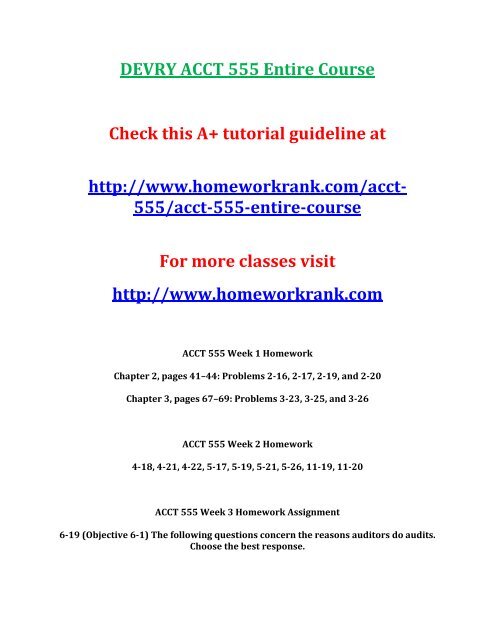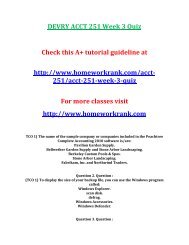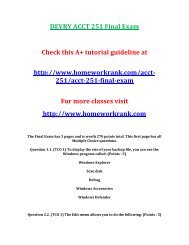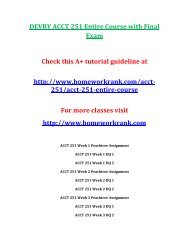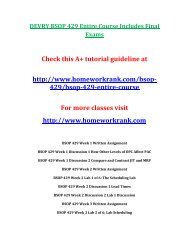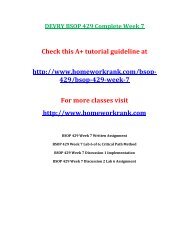DEVRY ACCT 555 Entire Course
Create successful ePaper yourself
Turn your PDF publications into a flip-book with our unique Google optimized e-Paper software.
<strong>DEVRY</strong> <strong>ACCT</strong> <strong>555</strong> <strong>Entire</strong> <strong>Course</strong><br />
Check this A+ tutorial guideline at<br />
http://www.homeworkrank.com/acct-<br />
<strong>555</strong>/acct-<strong>555</strong>-entire-course<br />
For more classes visit<br />
http://www.homeworkrank.com<br />
<strong>ACCT</strong> <strong>555</strong> Week 1 Homework<br />
Chapter 2, pages 41–44: Problems 2-16, 2-17, 2-19, and 2-20<br />
Chapter 3, pages 67–69: Problems 3-23, 3-25, and 3-26<br />
<strong>ACCT</strong> <strong>555</strong> Week 2 Homework<br />
4-18, 4-21, 4-22, 5-17, 5-19, 5-21, 5-26, 11-19, 11-20<br />
<strong>ACCT</strong> <strong>555</strong> Week 3 Homework Assignment<br />
6-19 (Objective 6-1) The following questions concern the reasons auditors do audits.<br />
Choose the best response.
Which of the following best describes the reason why an independent auditor<br />
reports on financial statements?<br />
Because of the risk of material misstatement, an audit should be planned and<br />
performed with an attitude of<br />
The major reason an independent auditor gathers audit evidence is to<br />
6-20 (Objective 6-3) The following questions deal with errors and fraud. Choose the<br />
best response.<br />
An independent auditor has the responsibility to design the audit to provide<br />
reasonable assurance of detecting errors and fraud that might have a material effect<br />
on the financial statements. Which of the following, if material, is a fraud as defined<br />
in auditing standards?<br />
What assurance does the auditor provide that errors, fraud, and direct-effect illegal<br />
acts that are material to the financial statements will be detected?<br />
6-27 (Objectives 6-6, 6-7) The following are specific transaction-related audit<br />
objectives applied to the audit of cash disbursement transactions (a through f),<br />
management assertions about classes of transactions (1 through 5), and general<br />
transaction-related audit objectives (6 through 11).<br />
Specific Transaction-Related Audit Objective<br />
Recorded cash disbursement transactions are for the amount of goods or services<br />
received and are correctly recorded.<br />
7-25 (Objectives 7-3, 7-4) The following questions concern persuasiveness of<br />
evidence. Choose the best response.<br />
Which of the following types of documentary evidence should the auditor consider to<br />
be the most reliable?<br />
Which of the following statements concerning audit evidence is true?<br />
Audit evidence can come in different forms with different degrees of persuasiveness.<br />
Which of the following is the least persuasive type of evidence?<br />
Which of the following presumptions is correct about the reliability of audit<br />
evidence?
7-26 (Objectives 7-5, 7-6) The following questions concern audit documentation.<br />
Choose the best response.<br />
Which of the following isnota primary purpose of audit documentation?<br />
During an audit engagement, pertinent data are compiled and included in the audit<br />
files. The audit files primarily are considered to be<br />
Although the quantity, type, and content of audit documentation will vary with the<br />
circumstances, audit documentation generally will include the<br />
The permanent file of an auditor’s working papers most likely would include copies<br />
of the<br />
7-27 (Objective 7-4) The following are examples of documentation typically obtained<br />
by auditors:<br />
7-28 (Objective 7-4) The following are examples of audit procedures:<br />
8-25 (Objectives 8-1, 8-3) The following questions concern the planning of the<br />
engagement. Select the best response.<br />
Which of the following is an effective audit planning procedure that helps prevent<br />
misunderstandings and inefficient use of audit personnel?<br />
8-28 (Objectives 8-2, 8-3, 8-4, 8-5) The following are various activities an auditor<br />
does during audit planning.<br />
<strong>ACCT</strong> <strong>555</strong> Week 4 Homework Assignment<br />
9-22 (Objectives 9-1, 9-2) The following questions deal with materiality. Choose the<br />
best response.<br />
9-23 (Objectives 9-6, 9-8) The following questions concern audit risk. Choose the<br />
best response.
· Some account balances, such as those for pensions and leases, are the result of<br />
complex calculations. The susceptibility to material misstatements in these types of<br />
accounts is defined as<br />
9-24 (Objective 9-9) The following questions deal with audit risk and evidence.<br />
Choose the best response.<br />
10-30 (Objectives 10-1, 10-2, 10-7) The following are general questions about<br />
internal control. Choose the best response.<br />
· When considering internal control, an auditor must be aware of the concept of<br />
reasonable assurance, which recognizes that the<br />
<strong>ACCT</strong> <strong>555</strong> Week 5 Homework Assignment<br />
Chapter 12, pages 390–397: Problems 12-17, 12-18, and 12-27<br />
Chapter 13, pages 429–430: Problems 13-22, 13-23, and 13-24<br />
<strong>ACCT</strong> <strong>555</strong> Week 6 Homework<br />
Chapter 14 Problems 14-21, 14-22, 14-23 14-24,<br />
Chapter 15 Problems 15-22, 15-24, 15-25,<br />
Chapter 16 Problem 220,21,22,24,28<br />
Chapter 17 Problem 28<br />
<strong>ACCT</strong> <strong>555</strong> Week 7 Homework Assignment<br />
20-17<br />
a.A factory foreman at Steblecki Corporation discharged an hourly worker but did<br />
not notify the human resources department. The foreman then forged the worker’s<br />
signature on time cards and work tickets and, when giving out the checks, diverted<br />
the payroll checks drawn from the discharged worker to his own use. The most<br />
effective procedure for preventing this activity is to
An auditor found that employee time records in one department are not properly<br />
approved by the supervisor. Which of the following could result?<br />
The purpose of segregating the duties of hiring personnel and distributing payroll<br />
checks is to separate the<br />
20-20<br />
· Identify whether each of the procedures is primarily a test of control or a<br />
substantive test of transactions.<br />
· Identify the transaction-related audit objective(s) of each of the procedures.<br />
21-17<br />
Which of the following controls will most likely justify a reduced assessed level of<br />
control risk for the occurrence assertion for purchases of inventory?<br />
21-18<br />
When an auditor tests a client’s cost accounting records, the auditor’s tests are<br />
primarily designed to determine that<br />
21-19<br />
Which of the following procedures is the auditor least likely to perform on the actual<br />
date the physical inventory count is observed?<br />
21-20<br />
For each of the preceding questions, state the purpose of the internal control.<br />
For each internal control, list a test of control to test its effectiveness.<br />
For each of the preceding questions, identify the nature of the potential financial<br />
misstatement(s) if the control is not in effect.<br />
For each of the potential misstatements in part c, list a substantive audit procedure<br />
to determine whether a material misstatement exists<br />
<strong>ACCT</strong> <strong>555</strong> Week 7 <strong>Course</strong> Project Smackey Dog Foods Inc
<strong>ACCT</strong> <strong>555</strong> Midterm<br />
1. (TCO F) Which of the following procedures should an auditor generally perform<br />
regarding subsequent events?<br />
2. (TCO A) An auditor reads the letter of transmittal accompanying a county’s<br />
comprehensive annual financial report and identifies a material inconsistency with<br />
the financial statements. The auditor determines that the financial statements do not<br />
require revision. Which of the following actions should the auditor take?<br />
3. (TCO F) An auditor’s independence is considered impaired if the auditor has<br />
4. (TCO B) When an independent CPA is associated with the financial statements of<br />
a publicly held entity but has not audited or reviewed such statements, the<br />
appropriate form of report to be issued must include a(an):<br />
5. (TCO F) Which is not a characteristic of the reliability of evidence?<br />
6. (TCO C) According to PCAOB standards, the nature and extent of required<br />
planning activities for an issuer audit are influenced by all of the following factors,<br />
except for:<br />
7. (TCO F) Analytical procedures must be used during which phase(s) of the audit?<br />
Test of controls OR planning OR completion<br />
8. (TCO F) In a financial statement audit, inherent risk is evaluated to help an<br />
auditor assess which of the following?<br />
9. (TCO F) The primary purpose of performing analytical procedures in the<br />
planning phase of an audit is to<br />
10. (TCO G) The most widely used profitability ratio is<br />
11. (TCO G) Which ratio is best used to assess a company’s ability to meet its longterm<br />
debt obligations?<br />
12. (TCO A) Match the following definitions to the appropriate terms.<br />
13. (TCO B) The following is a portion of a qualified audit report issued for a private<br />
company.<br />
To the shareholders of Tamarak Corporation,
We have audited the accompanying balance sheet of Tamarak Corporation as of<br />
October 31, 2009, and the related statements of income, retained earnings, and cash<br />
flows for the past year. These financial statements are the responsibility of the<br />
company’s management. Our responsibility is to express an opinion on these<br />
financial statements based on our audit.<br />
We conducted our audit in accordance with auditing standards generally accepted in<br />
the United States of America. Those standards require that we plan and perform the<br />
audit to obtain reasonable assurance about whether the financial statements are<br />
free of material misstatement. An audit includes examining, on a test basis, evidence<br />
supporting the amounts and disclosures in the financial statements. An audit also<br />
includes assessing the accounting principles used and significant estimates made by<br />
management, as well as evaluating the overall financial statement presentation. We<br />
believe that our audit provides a reasonable basis for our opinion.<br />
The company has included in property and debt in the accompanying balance sheet<br />
certain lease obligations that, in our opinion, should be expensed in order to<br />
conform with generally accepted accounting principles. If these lease obligations<br />
were capitalized, property would be decreased by $4,000,000, long-term debt by<br />
$2,000,000, and retained earnings by $180,000 as of October 31, 2009, and net<br />
income and earnings per share would be decreased by $180,000 and $0.62,<br />
respectively, for the past year.<br />
3. (TCO C) The following situation involves a possible violation of the AICPA’s code<br />
of professional conduct. For this situation, (1) determine the applicable rule number<br />
from the code, (2) decide whether or not the code has been violated, and (3) briefly<br />
explain how the situation violates (or does not violate) the code. Your answer should<br />
be set up something like this:<br />
Rule # _____ Violation? Yes or No.<br />
Provide a one- or two-line explanation.<br />
Auditor Tex Gato of the CPA firm Smackey and Smackey, CPAs, enjoyed auditing his<br />
favorite client, Super Pup Dog Food, because the client would allow him to take home<br />
to his dog a variety of dog food samples that amounted to a year’s worth of dog food.<br />
4. (TCO C) The following situation involves a possible violation of the AICPA’s code<br />
of professional conduct. For this situation, (1) determine the applicable rule number<br />
from the code, (2) decide whether or not the code has been violated, and (3) briefly<br />
explain how the situation violates (or does not violate) the code. Your answer should<br />
be set up something like this:<br />
Rule # _____ Violation? Yes or No.<br />
Provide a one- or two-line explanation.
Howard Cunningham & Co., CPAs, designates its firm as Members of the American<br />
Institute of Certified Public Accountants. All of the partners of the firm are CPAs.<br />
However, one of the partners has recently chosen to allow her membership to lapse<br />
because of personal reasons.<br />
5. (TCO C) Under the provisions of the Sarbanes-Oxley Act of 2002 (SOX), the audit<br />
committee of a public company has specific guidelines to which employees must<br />
adhere. Discuss some of the mandated features of the audit committee of a public<br />
company under SOX.<br />
6. (TCO D) Discuss some of the steps the AICPA and the accounting profession as a<br />
whole can and are taking to reduce practitioners’ exposure to lawsuits. You answer<br />
should provide at least five steps.<br />
7. (TCO F) Match nine of the terms (A–K) with the definitions provided below (1–<br />
9).<br />
A – Foot<br />
B – Compute<br />
C – Scan<br />
D – Inquire<br />
E – Count<br />
F – Trace<br />
G – Recompute<br />
H – Read<br />
I – Examine<br />
J – Observe<br />
K – Compare<br />
_____ 1: A calculation done by the auditor independent of the client<br />
_____ 2: Addition of a column of numbers to determine if the total is the same as the<br />
client’s<br />
_____ 3: A comparison of information in two different locations<br />
_____ 4: A use of the senses to assess certain activities<br />
_____ 5: Following details of transactions from original documents to journals<br />
_____ 6: A less detailed examination of a document or record to determine if there is<br />
something unusual warranting further investigation<br />
_____ 7: Obtaining information from the client in response to specific questions<br />
_____ 8: A determination of assets on hand at a given time<br />
_____ 9: An examination of written information to determine facts pertinent to the<br />
audit<br />
8. (TCO G) Discuss the essential activities involved in the initial planning of an<br />
audit.
<strong>ACCT</strong> <strong>555</strong> Final Exam<br />
1. (TCO B) An auditor was unable to obtain sufficient appropriate audit evidence<br />
concerning certain transactions due to an inadequacy in the entity’s accounting<br />
records. The auditor would choose between issuing a(an): (Points : 5)<br />
2. (TCO K) An auditor should consider which of the following when evaluating the<br />
ability of a company to continue as a going concern? (Points : 5)<br />
3. (TCO A) An auditor’s independence is considered impaired if the auditor has:<br />
(Points : 5)<br />
4. (TCO H) Which of the following should be included as a written representation<br />
from management? (Points : 5)<br />
5. (TCO E) An auditor would most likely be concerned with internal controls that<br />
provide reasonable assurance about the: (Points : 5)<br />
1.(TCO A) In performing an ATTEST Engagement A CPA would be required to do what<br />
as part of the engagement? (Points : 19)<br />
2.(TCO B) When a CPA performs an Audit the Client is always looking to receive a<br />
“CLEAN OPINION” or an Unqualified Opinion. Explain what your client must do for a<br />
CPA to justify that Unqualified Opinion? (Points : 19)<br />
3.(TCO C) – Based upon the below 4 situations – explain your position of “why” or<br />
“why not” the following circumstances would have violated the professions ethical<br />
standards when you are a practicing CPA?<br />
4.(TCO D) Discuss five steps individual practicing auditors can take to minimize their<br />
legal liability.(Points : 19)<br />
5.(TCO F) Sarbanes Oxley requires that per Section 404 that Internal Controls within<br />
a publicly held company are to be reviewed, evaluated and tested at year end to<br />
insure that adequate controls are in place. In addition to understanding the Internal<br />
Controls present within your client’s company, the auditor must also evaluate<br />
whether these controls are in place, and implemented. How does an auditor evaluate<br />
these controls to see that they are working and in place?(Points : 19)<br />
1. (TCO E) What is COSO? Describe the 5 elements of COSO’s Internal Control-<br />
Integrated Framework. Provide an example of each of those components and explain
why they are important in providing “Reliable Financial Reporting” for a company.<br />
Please provide a complete answer for full points. (Points : 30)<br />
2.(TCO G) Business risk must be assessed in performing an audit.<br />
(a) Define business risk in association with an audit and describe several sources of<br />
such risk.<br />
(b) How does business risk relate to the performance of preliminary analytical<br />
procedures in an audit?<br />
(c) There are four major areas in planning an audit engagement and there are<br />
subparts to each of the four major areas. Please identify the four major areas and the<br />
subparts that are associated with the major areas.(Points : 30)<br />
3.(TCO H) Audit Risk consists of inherent risk, control risk, and detection risk.<br />
(a) Please completely define each of the above.<br />
(b) Indicate whether each of the statements below is true or false and explain your<br />
position:<br />
(1) The risk that material misstatement will not be prevented or detected on a timely<br />
basis by internal controls can be reduced to zero by having effective controls in<br />
place.<br />
(2) Detection Risk is a function of the efficiency of an auditing procedure.<br />
(3) Cash is more susceptible to theft than an inventory of coal because it has greater<br />
inherent risk?<br />
(4) The Inherent risk of the theft of an inventory of cellphones at a mall store is<br />
greater than the misappropriation of cash at a COSTCO Store?(Points : 30)<br />
4.(TCO I) Accounts Receivable – For each of the following, please explain if an<br />
auditor’s review of the client’s sales cutoff would detect these problems:<br />
(a) Would excessive goods returned for credit be detected by a sales cut-off test –<br />
why or why not?<br />
(b) Would unrecorded sales discounts be detected by a sales cut-off test – why or<br />
why not?<br />
(c) Lapping of year-end accounts receivable be detected by a sales cut-off test – why<br />
or why not?<br />
(d) Inflated sales for the year – could it be detected by a sales-cut-off test – why or<br />
why not?(Points : 30)
5.(TCO J) One of the major problems in a computer system is that incompatible<br />
functions may be performed by the same individual. Identify from the below choices<br />
the control compensating for inadequate segregation of duties in a computer system.<br />
Explain why you have selected your response.<br />
(a) Echo Checks<br />
(b) A check digit system<br />
(c) Computer-Generated hash totals<br />
(d) A computer access log (Points : 30)<br />
6.(TCO K) You are the Senior Auditor for WWZ Co. and you have completed the<br />
testing of all the accounts. However, prior to issuing your report, what are at least<br />
five other procedures or reviews that must be performed prior to issuing your<br />
report? Explain your responses(Points : 30)<br />
<strong>ACCT</strong> <strong>555</strong> Week 8 Final Exam<br />
1. (TCO A) There are ten generally accepted auditing standards, divided into three<br />
categories. What are the standards of reporting?<br />
2. (TCO A) Distinguish between generally accepted auditing standards (GAAS) and<br />
generally accepted accounting principles (GAAP). What professional organization<br />
establishes GAAS? What professional organization establishes GAAP?<br />
3. Assume you are the partner in charge of the audit of Franklin Corporation’s<br />
2002 financial statements. The audit report has not yet been prepared. In each<br />
independent situation following, indicate the appropriate opinion you should issue<br />
and why you would issue that opinion<br />
4. State whether there is any violation of the AICPA Code of Professional Conduct,<br />
and the nature of the violation. Where there is a violation, evaluate the potential<br />
legal liability the accountant may face. Justify your position<br />
5. Discuss at least five of the actions that can be taken by individual CPAs, to<br />
protect themselves from legal liability<br />
6. (TCO E) Bobby Thigpen, waiter at Relief Stop, has been taking cash from the<br />
restaurant. Thigpen prepares a customer’s check from which the customer pays.<br />
Thigpen then destroys the check, and prepares a new one with different items of
lower cost. He presents the new check and indicated amount on the check to the<br />
cashier, and saves the excess cash for himself. Question: Formulate three internal<br />
control features that the restaurant could implement, to eliminate this defalcation<br />
7. Three types of legal documents and records that auditors examine in the<br />
planning phase of an audit are the corporate charter and bylaws, corporate minutes<br />
of meetings of the board of directors and stockholders, and contracts. Discuss the<br />
audit-relevant information contained in each of these three types of documents that<br />
an auditor should be aware of early in the audit.<br />
8. (TCO F) What are specific audit objectives? Explain their relationship to the<br />
general audit objectives. (Points: 25)<br />
2.(TCO H) Explain why it is necessary to allocate the preliminary judgment about<br />
materiality to individual accounts (segments) in the financial statements. Also<br />
explain why allocating to balance sheet accounts is more common than allocating to<br />
income statement accounts. (Points: 25)<br />
Allocating the preliminary judgment about materiality to individual segments is<br />
necessary because evidence is accumulated for segments rather than for the<br />
financial statements as a whole. Allocating to segments establishes a tolerable<br />
misstatement amount for each segment, which helps the auditor decide the<br />
appropriate audit evidence to accumulate for each segment. Most practitioners<br />
allocate materiality to balance sheet accounts rather than income statement<br />
accounts because there are fewer balance sheet than income statement accounts<br />
3. (TCO I) For each of the following potential misstatements, provide one potential<br />
audit test that could be used to detect the misstatement<br />
4. (TCO I) Describe how the auditor tests the classification objective for accounts<br />
receivable. (Points: 25)<br />
The classification objective is tested by reviewing the aged trial balance for material<br />
receivables from affiliates, officers, directors, or other related parties. If notes<br />
receivable or accounts that should not be classified as a current asset are included<br />
with the regular accounts, these should also be segregated. Finally, if credit balances<br />
in accounts receivable are significant, it is appropriate to reclassify them as accounts<br />
payable<br />
5. The design of tests of details of balances for inventory is affected by audit<br />
results from multiple cycles. Identify the cycles, other than the inventory and<br />
warehousing cycle, that affect the audit of inventory<br />
6. Describe three computer auditing techniques available to the auditor
7. (TCO K) Match seven of the terms (a-p) with the description/definitions<br />
provided below (1-7):


